Improving Safety Training Among Immigrant Populations
Learning & Development and HR professionals are often tasked with creating safety training for their organization’s workforce. But, what happens when a large portion of the workforce is from another country or speaks a different language? Can safety training simply be translated to be effective? In this article, we’ll focus on improving safety training among immigrant populations and ways you can create safer work places.
3 Goals to Ensure Effective Safety Training
While safety training is obviously a benefit to companies and their workers, it is often created with the purpose of achieving certain goals. Commonly, there are three main goals for effective safety training:
- Regulatory Compliance – If you are complying with a regulatory mandate, you will likely have specific guidelines to incorporate including, but not limited to: ensuring specific topics are covered, all employees are included, training at regular intervals.
- Employee Compliance – Are workers aware of workplace hazards and safety measures as well as company policies and procedures?
- Improved Performance – How do you measure efficacy? Did the training lower accident or incident rates? What kind of impact has the training had on performance and productivity?
Immigrant Workers Are At Higher Risk
As a nation of immigrants, the United States workforce has always been comprised of workers from diverse ethnic cultures and languages. In recent years, immigrant workers, and specifically Latino workers, has risen significantly. Unfortunately, this rise has led to a disproportionate number of safety related concerns, specifically with Latino workers. In an article published by the CDC, Latino workers suffer significantly higher rates of workplace fatalities than non-Latino workers. In fact, “Latino immigrants to the U.S. have a workplace fatality rate of 5.9 per 100,000 which is almost 50% higher than the rate for all workers.”
Improve Safety Training with Localization
While workplace culture, social structures, and knowledge can all contribute to safety challenges, the most important issue for many immigrants, especially Latino workers, is the language barrier. Improving safety training among immigrant populations starts with safety training that can be easily digested by a diverse employee population. Mere translation of safety training content is not enough. As a matter of fact, simple translation does not increase efficacy rates, according to SafetySkills, an international safety training company. They suggest, “Avoid bilingual training that is little more than an English-language course with closed captioning in another language, as this is proven to be not nearly as effective as a fully-immersive experience.”
For safety training among immigrant populations to be effective, it must be delivered and consumed by the learner with four main considerations:
- Safety training should be localized for the employee/learner’s. This process often includes culturally appropriate text, voice, photos, animation, and video replacement, as part of a multimedia experience.
- Q&A opportunities for the learner to engage the safety instructor in their native language.
- Self-paced eLearning modules that allow the user to go at their own pace and in their own setting, to digest content in the way best suited for their learning style.
- Measuring data and efficacy to ensure that content is impacting desired outcomes.
Studies show that eLearning can make it much easier to distribute the exact same training for diverse audiences. In today’s Covid environment, this can also ensure that safety, production, and performance information is disseminated quicker and more efficiently, even to large audiences.
Global eLearning provides translation and localization services to meet the unique needs of the Learning & Development industry. If you are interested in improving safety training among immigrant populations, we can help you localize content for better outcomes! Contact us to get started.
Sources:
https://safetyskills.com/training-effective-native-language/
https://blogs.cdc.gov/niosh-science-blog/2014/12/04/immigrant-osh/


